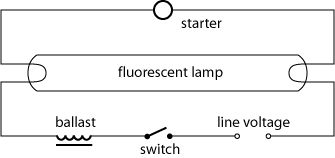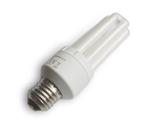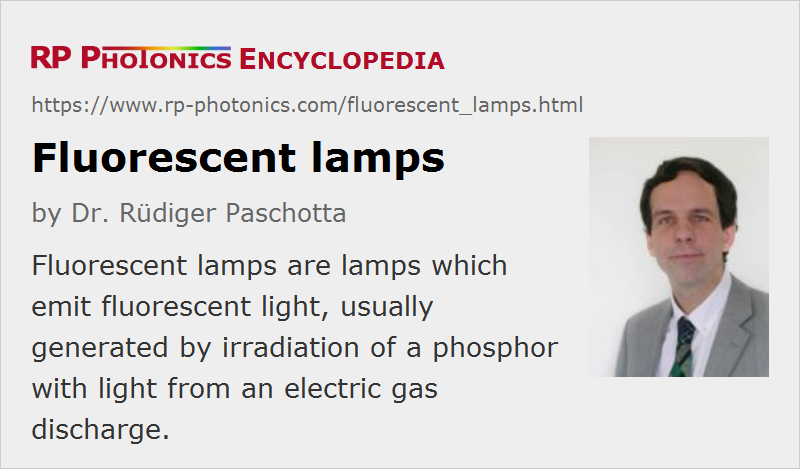Fluorescent Lamps
Definition: lamps which emit fluorescent light, usually generated by irradiation of a phosphor with light from an electric gas discharge
More general term: gas discharge lamps
German: Fluoreszenzlampen
Category: non-laser light sources
How to cite the article; suggest additional literature
Author: Dr. Rüdiger Paschotta
Fluorescent lamps are devices used for illumination purposes which emit fluorescent light. That fluorescence occurs in some phosphor (fluorescent material), which is usually excited by ultraviolet light from an electric discharge in some gas, usually in mercury vapor. The emitted light is typically white.
The most common fluorescent lamps contain mercury vapor (mixed with argon or xenon) inside a glass tube (fluorescent tube) with a length between 20 cm and 2.5 m and a diameter between 1 cm and a few centimeters. As in other mercury vapor lamps, an electric discharge excites the mercury atoms via inelastic scattering of electrons: electrons are accelerated by the electric field in the tube, and during a collision of an electron with a mercury atom, part of the kinetic energy of an electron is converted into excitation energy of the mercury atom. Thereafter, the mercury atom can emit light, mostly in the ultraviolet spectral region at wavelengths of 254 nm and 185 nm. This part of the process is called cathodoluminescence (→ luminescence).
Subsequently, a fluorescent coating (called the phosphor) on the inner surface of the tube absorbs the ultraviolet light and converts it into fluorescent light, mostly in the visible spectral region. (Any remaining ultraviolet light is absorbed in the glass tube.) The phosphor contains several active (light-emitting) substances, which are mixed in such a way that the overall emission spectrum results in the perception of white light.
Color Tones and Color Rendering
The emission spectrum of any fluorescent lamp, as recorded with an optical spectrum analyzer (e.g. a spectrograph), can easily be distinguished from that of an incandescent lamp: it is much more structured, with a high power spectral density in some spectral regions and much lower values at other wavelengths. Nevertheless, the visual impression for the human eye can be similar to day light. This is essentially because the eye has only three different kinds of photoreceptors for distinguishing colors; only the relative excitation levels for these kinds of photoreceptors matter for the color impression. In addition, the human visual sense quickly adapts its color calibration according the spectrum of the ambient light; for that reason, the strong changes in the spectrum of day light, e.g. between noon and late afternoon, are hardly perceived.
By varying the composition of the phosphor, different color tones can be obtained. A “warm” (soft) color tone is often preferred for residential lighting; it mimics the warmer color tone of sunlight in the evening, which can contribute to a relaxing atmosphere. On the other hand, light with a “cold” color tone (with a higher color temperature) is more suitable for, e.g., offices; it is better matching sunlight at noon and supports concentrated work.
Even when the color tone is optimized for the application, the non-uniform optical spectrum of a fluorescent lamp may somewhat modify the color appearance of objects which it illuminates. This is essentially because the optical properties of an object are probed primarily in the wavelength regions of strong emission, whereas the properties in some regions with weak emission do not contribute substantially to the overall visual impression. Such effects can be quantified with a color rendering index (CRI). Some fluorescent lamps have a low color rendering index and are therefore not suitable when subtle color differences can matter, e.g. in a photo studio. However, this depends strongly on the composition of the phosphor; many modern lamps using a triphosphor mixture containing europium and terbium can achieve a very high color rendering index. Various marketing terms such as “natural full spectrum”, “high definition” and “day light” are used for lamps with a high color rendering index.
Electrical Aspects
The electric discharge occurs between two tungsten filaments. In most fluorescent lamps, these are coated with various oxides favoring thermionic emission. In the start-up phase, the electrodes are heated with a stronger than normal current, and the discharge is started with a high-voltage spike. Once the gas is ionized, its electrical conductivity becomes substantial, and the voltage required for sustaining the discharge drops to well below 200 V. The electric current needs to be stabilized with some electric ballast, as a higher current in the gas discharge would reduce the resistance, allowing the current to rise further.
Larger fluorescent lamps usually use an inductor coil as the ballast, which is possible for operation with the usual AC current. The inductor also serves to provide the high-voltage spike for start-up. During that phase, the gas discharge is electrically bypassed, causing a relatively large current to flow through the electrodes and the inductor. After a few seconds, the electric bypass is removed, and the sudden drop in current causes the inductor to produce the voltage spike which starts the discharge. In the steady state, the current is much lower than in the start-up phase, so that the heating of the electrodes is weak. The start-up process is controlled by a small starter (automatic starting switch), containing a small glow tube and a bimetallic switch. See Figure 1 for a typical electrical circuit.

Instead of a simple inductor, a more sophisticated electronic circuit can be used as a ballast and for start-up. (Strictly, such electronics can in many cases not be called a ballast.) This can have several advantages:
- The electronic device can be more compact, allowing its use in compact fluorescent lamps (see below).
- Operation with a DC supply is possible with suitable electronics, whereas a simple inductor could not be used in that case.
- The electronics can operate at a frequency which is much higher than that of the line voltage. This (combined with other details) allows for a higher power efficiency. Also, flicker is essentially eliminated.
On the other hand, there are concerns related to electrosmog (see below).
Dimming (reducing the brightness) is possible only with special electronic devices, which are not very widespread. Electronic dimmers made for incandescent lamps are not suitable for dimming fluorescent lamps.
Fluorescent lamps typically need some warm-up time before reaching the full brightness, essentially because sufficient mercury vapor pressure (around 3 mbar) needs to be built up. The warm-up time can be as short as a few seconds, but is a full minute in other cases. For operation outside buildings, a fluorescent lamp may in winter not reach its optimum temperature, and thus have a reduced brightness.

There are so-called cold cathode fluorescent lamps (CCFL), where thermionic emission of the cathode is not used: the electrodes have no oxide coating, and the operation temperature is below the thermionic emission temperature, even though it may not be low. One accepts a higher voltage drop at the cathode, which somewhat reduces the power efficiency. Advantages of this concept are that the lifetime can be higher, and that instant on-off switching is possible.
Compact Fluorescent Lamps

Conventional straight or curved fluorescence tubes are often too large to replace incandescent lamps. Therefore, compact fluorescent lamps (fluorescent light bulbs) were developed which have a size comparable to an incandescent lamp, and can be used in the same type of light fixture. That compact form was made possible by developing relatively small tubes (sometimes in a wound form) and compact electronic ballasts, which also enhance the power efficiency and reduce flicker. There are also non-integrated compact lamps, used with a separate electronic ballast, so that the lamp can be exchanged after its lifespan, and the long-life electronic ballast can be reused.
Lifetime
The lifetime of a fluorescent lamp can exceed 10 000 hours when it is operated during long time intervals. Frequent switching on and off can substantially reduce the device lifetime. Some electronic ballasts, particularly for compact fluorescent bulbs, have been optimized for frequent switching, making such lamps much less vulnerable.
Energy Efficiency and Environmental Aspects
Although part of the energy of the ultraviolet light from the mercury emission is lost in the phosphor, fluorescence lights are still several times more energy-efficient than incandescent lamps. Instead of quoting the energy conversion efficiency, it is more sensible to consider the luminous efficacy, which takes into account the wavelength-dependent sensitivity of the eye. Luminous efficacies of fluorescent lamps can reach the order of 100 lumens per watt. (When a high color rendering index is needed, somewhat lower efficacies may have to be accepted.) This can be compared with roughly 10–20 lm/W for incandescent bulbs (where higher values apply to higher-power devices) and somewhat over 20 lm/W for halogen lamps. The use of a fluorescent lamp instead of an incandescent bulb can thus easily reduce the electric power consumption for a given luminosity by 80%. The savings in energy costs can be a multiple of the increased price of the lamp, and the reduced energy consumption is associated with reduced pollution and reduced emission of green house gases (carbon dioxide) from power plants.
On the other hand, the energy consumption for producing a fluorescent lamp is several times higher than that for an incandescent lamp. However, that amount of energy is still much smaller than that used during operation, and also the device lifetime (see above) is much longer. Therefore, the additional amount of energy for production is compensated within a small fraction of the lifetime, and does not constitute a valid argument against using fluorescent lamps.
The higher energy efficiency of fluorescent lamps is also associated with a correspondingly lower emission of heat. While heat emission may be welcome in heated buildings, that contribution to heating is relatively inefficient due to the energy losses in typical power plants. In air-conditioned buildings, heating by lamps is undesirable, as it can significantly increase the electricity consumption of the cooling devices, so that the energy savings by using efficient fluorescent lamps are larger than the direct savings in the lamp. Note that the heating by lamps can also have unwanted local side effects, such as creating the risk of fire in wooden buildings.
After their lifespan, fluorescent tubes should be recycled, mainly because they contain some amount of the poisonous mercury: a few milligrams for compact fluorescent lamps, and somewhat more for long tubes. (For comparison, clinical thermometers used to contain roughly 1 g of mercury, and many other electrical devices, which can partly still been sold, contain similar amounts.) In the case of compact fluorescent lamps, the electronics can also contain harmful substances. Unfortunately, consumers are often not aware of this (particularly in the context of compact fluorescent lamps), so that the lamps are disposed of as normal garbage, and particularly the mercury pollutes the environment. However, that fact should not be exaggerated, because only a tiny fraction of the mercury in household and commercial wastes is from lamps. Also, coal-powered electricity plants emit substantial amounts of mercury; in fact they cause the by far largest contribution to the global mercury emissions. For example, the operation of 100-W incandescent lamps over 5000 hours, causing an electricity consumption of 500 kWh, can easily be associated with mercury emissions of 10–20 mg, even if the electricity is not from coal-powered plants only. This is comparable to the amount of mercury in a 25-W fluorescent lamp, which produces a similar amount of light during its lifetime. Therefore, even without any lamp recycling, fluorescent lamps do not necessarily cause higher overall mercury emissions, and with recycling the situation can be substantially better.
Concerns About Electrosmog
Some consumers are concerned about the emission of electrosmog by fluorescent lamps. This is based on the fact that particularly electronic ballasts in compact fluorescent lamps exhibit significant electric and magnetic fields at higher frequencies in their immediate surroundings. On the other hand, efficient fluorescent lamps cause smaller currents in the wires, and thus smaller magnetic fields around the household wiring. Also, they are just one of many types of devices in a household which generate electric and magnetic fields.
The main question in this context is whether such electromagnetic emissions are associated with health risks, and how serious these may be. This question is very difficult to answer due to a lack of conclusive data. There appears to be some evidence that low-frequency electromagnetic fields have some biological effects, but despite intensive investigations there is no scientific proof that there are significant health risks. In that situation, it appears reasonable to reduce exposure to the fields where it is easily possible (e.g. by avoiding long-term presence very close to compact fluorescent tubes), but not to give up the very proven beneficial effects of the reduced electricity consumption of fluorescent lamps.
Other Health Concerns
There are many other health concerns against fluorescent lamps, which are however poorly founded:
- The emitted optical spectrum differs from that of incandescent bulbs: it is more structured, and its color temperature can be different. However, there is no evidence that structured emission spectra are a health risk; only, they make it more difficult to judge colors. Therefore, most fluorescent lamps are not suitable for certain special applications e.g. in the context of arts. Also, claims concerning risks related to the blue component of the emission are rather implausible as sunlight contains much more intense blue components. The color temperature can be relevant for health, but what color temperature is appropriate depends very much on the circumstances. For example, a low color temperature (e.g., 2500 K) is suitable for room lights in the evening, as otherwise the sleep at night may be impaired, whereas a higher color temperature (4000 K or higher, closer to 6000 K as for daylight at noon) is better in offices to avoid tiredness. It is important to select lamps with appropriate color temperature for the given application, and it is obviously helpful that models with rather different colors temperatures are readily available.
- Tiny amounts of ultraviolet light may be emitted by fluorescent lamps due to incomplete absorption in the phosphor and the glass, but these amounts are very weak compared with those in sunlight.
- Flickering can be a problem, but noticeable flickering occurs only with lamps which are defect or close to their end of life. During normal operation, a 50-Hz line frequency often causes a substantial modulation of the light output at 100 Hz (often even with electronics balasts, having only small filtering capacitors). That modulation, however, is much too fast to be noticed and can hardly be a health issue. (In the U.S., the 60-Hz line frequency causes an even faster modulation.)
- The electronic parts particularly of compact fluorescent lamps may emit some amounts of poisonous substances. In some bad cases, this even leads to a perceivable smell. Normally, the concentrations of such substances in the room air are extremely small and compete with emissions from many other sources, including devices which contain more electronics (like TV sets). Noteworthy concentrations have only been obtained in artificial measurements where a lamp was contained in a very small volume of air.
Special Types of Fluorescent Lamps
There are electrodeless fluorescent induction lamps, where an electromagnetic field transfers the electric energy on the gas discharge, so that electrodes are no longer needed. Resulting benefits are a further increased bulb lifetime and a wider range of usable light-emitting substances.
Competing Technologies
- Incandescent lamps are cheaper and more compact than fluorescent tubes, but have a lower efficiency and shorter lifetime.
- Light-emitting diodes (LEDs) begin to rival fluorescent lamps, since they can offer similarly high efficiencies while being very compact, lightweight and robust. However, their price per watt is still much higher.
- Some gas discharge lamps not involving fluorescence, such as sodium vapor lamps, can be more efficient than fluorescent lamps.
Suppliers
The RP Photonics Buyer's Guide contains 6 suppliers for fluorescent lamps.
Questions and Comments from Users
Here you can submit questions and comments. As far as they get accepted by the author, they will appear above this paragraph together with the author’s answer. The author will decide on acceptance based on certain criteria. Essentially, the issue must be of sufficiently broad interest.
Please do not enter personal data here; we would otherwise delete it soon. (See also our privacy declaration.) If you wish to receive personal feedback or consultancy from the author, please contact him e.g. via e-mail.
By submitting the information, you give your consent to the potential publication of your inputs on our website according to our rules. (If you later retract your consent, we will delete those inputs.) As your inputs are first reviewed by the author, they may be published with some delay.
See also: gas discharge lamps, mercury vapor lamps, fluorescence, phosphors, color rendering index, light-emitting diodes, incandescent lamps, halogen lamps
and other articles in the category non-laser light sources
 |




If you like this page, please share the link with your friends and colleagues, e.g. via social media:
These sharing buttons are implemented in a privacy-friendly way!